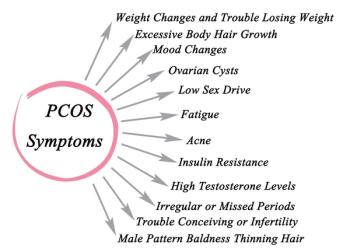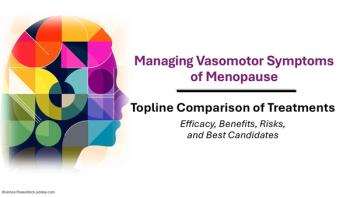
An intervention that included educational materials for clinicians on a multidisciplinary prenatal and postpartum care team helped drive acceptance.

An intervention that included educational materials for clinicians on a multidisciplinary prenatal and postpartum care team helped drive acceptance.

Pregnant patients' perceptions do not match clinician certainty on abstinence counseling during pregnancy, and clinicians may not be asking patients about their partner's substance use.

Researchers report an alarming number of missed opportunities to screen pregnant individuals for thyroid disease, including among women with a history of the condition.

Fewer than half of females who experienced heavy menstrual bleeding were given hormonal treatment, and far fewer were referred to gynecology, authors reported.

The findings support the potential cardiovascular advantages of the GLP-1RA class in women with PCOS, a population already at increased cardiometabolic risk.

While exercise is beneficial during pregnancy and ACOG recommends 150 mins/week, this is the first study to examine benefits of specific regimen elements on their own.

More than half of TikTok videos reviewed on hormonal birth control were patient-created and misleading while the majority of posts on endometrial cancer were by clinicians.

Two-thirds of pregnant individuals opted for either maternal vaccination against RSV or for neonatal monoclonal antibody therapy and for other vaccines recommended in pregnancy.

In a cancer survivorship clinic in urban New York, only one-quarter of long-term breast cancer survivors received genetic testing, contrary to current recommendations.

Secnidazole granules reduced recurrence rates to 20% over a period of 28 weeks in a small prospective pilot study, outperforming cumbersome daily regimens.

The most commonly reported adverse effects of high-dose glucocorticoid therapy were on bone health, cardiometabolic function, and height and growth.

The potential cardiovascular impact of prolonged oral corticosteroid therapy in the AD population observed in this study confirms longstanding cautions.

Semaglutide was associated with a significant reduction in risk for major adverse cardiovascular events after just 3 months of treatment in a population with established CVD.

Medical and nonpharmacologic treatment options for VMS range in efficacy and risk/benefit profile; a short slide show offers a topline look at how many compare.

Hot flashes and night sweats are just 2 of the myriad symptoms associated with menopause. Click through a quick refresher on the transition and effective treatments.

Semaglutide dosing was individually tailored for adults with obesity and supported with app-based coaching on diet, physical activity, and other lifestyle factors.

The Teal Wand allows women to collect a vaginal sample in the privacy of their home and, according to Teal Health, the test has 96% accuracy for cervical precancer.

Adults receiving the highest dose achieved 2 times the reduction in EASI scores vs placebo with responses emerging as early as day 8 of treatment.

The ability to predict which individuals will experience adverse events from GLP-1 therapy has great promise for more personalized treatment and improved clinical trial design.

The IL-22FA1 antagonist achieved positive outcomes for the primary endpoint based on percentage change in EASI from baseline to week 16 for 3 highest doses, according to LEO.

Data for GC reduction and improved A4 levels were consistent across subgroups stratified by sex, race, age, BMI, and baseline A4 levels, according to Neurocrine Biosciences.

The investigational mRNA-1083 vaccine induced superior immune responses against all 4 flu strains in adults aged 50-64 years and against 3 in adults 65 and older.

The chronotherapeutic approach aligns treatment with peak glucocorticoid sensitivity, so may mitigate onset of the inflammatory cascade that triggers nocturnal exacerbations.

Any increase in lipoprotein(a) levels was linked to increased risk of myocardial infarction and stroke; women and Black adults are most likely to be affected.

Publication of the phase 3 ARRECTOR trial findings precede an anticipated PDUFA date of May 22, 2025, for the investigational foam, now under FDA review.

The model demonstrated 70.63% accuracy for predicting depression, a common comorbidity seen in COPD and one that increases risk for negative outcomes.

EASL 2025. DA-1241 significantly reduced plasma ALT levels, improved systemic inflammatory and fibrosis biomarkers, according to drug developer MetaVia.

The new findings are contrary to previous research that found family history of AD increases desire for testing and support the "right not to know."

Rates of amputation in Black Americans with peripheral arterial disease are 3-times higher than that of their White counterparts. Dr Fakorede, discusses, here.

The increase in stool-based CRC testing is a logical trend, Hendrick said in an interview, given the convenience plus the 2 million younger adults now eligible for screening.